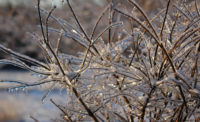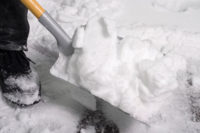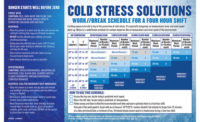For many, a sweater or an extra degree on the thermostat is all that’s needed to keep warm at work on a cold day. Not so for those working outside or in an area that is poorly insulated or without heat. These workers may be at risk of cold stress. What constitutes cold stress and its effects can vary across different areas of the country. In regions relatively unaccustomed to winter weather, near freezing temperatures are considered factors for cold stress. Whenever temperatures drop decidedly below normal and wind speed increases, heat can more rapidly leave the body. These weather-related conditions may lead to serious health problems.
Hypothermia, frostbite, trench foot, and chilblains are all illnesses and injuries caused by cold stress. Hypothermia occurs when the body’s temperature becomes abnormally low.
A body temperature that is too low affects the brain, making it difficult to think clearly or move well, and can eventually lead to death. Frostbite is an injury to the body caused by freezing tissues. It can cause permanent damage and in severe cases, lead to amputation. Trench foot is an injury of the feet resulting from prolonged exposure to wet and cold conditions. The wet feet lose heat faster and the circulation begins to shutdown, resulting in the skin tissue beginning to die. Chilblains are caused by the repeated exposure of skin to temperatures just above freezing to as high as 60°F. The cold exposure causes damage to the groups of small blood vessels in the skin. This damage is permanent and the redness and itching will return with additional exposure.
Preventing Cold Stress Illness and Injuries
There are many steps employers can take to protect workers from cold stress. Employers should try to schedule maintenance and repair jobs in cold areas for warmer months. When this is not possible, these jobs should be scheduled for the warmer part of the day. Employers should reduce the physical demands of workers by using relief workers or assigning extra workers for long, demanding jobs. Employers should provide warm break areas and warm liquids. Monitoring workers who are at risk of cold stress and providing training can also help prevent cold stress illness and injuries.
When cold environments cannot be avoided, workers should follow these recommendations to protect themselves from cold stress:
- Wear appropriate clothing.
- Wear several layers of loose clothing. Layering provides better insulation.
- Tight clothing reduces blood circulation. Warm blood needs to be circulated to the extremities.
- When choosing clothing, be aware that some clothing may restrict movement resulting in a hazardous situation.
- Make sure to protect the ears, face, hands and feet in extremely cold weather.
- Boots should be waterproof and insulated.
- Wear a hat; it will keep your whole body warmer. (Hats reduce the amount of body heat that escapes from your head.)
- Move into warm locations during work breaks; limit the amount of time outside on extremely cold days.
- Carry cold weather gear, such as extra socks, gloves, hats, jacket, blankets, a change of clothes and a thermos of hot liquid.
- Include a thermometer and chemical hot packs in your first aid kit.
- Avoid touching cold metal surfaces with bare skin.
- Monitor your physical condition and that of your coworkers.
For information on hypothermia, frostbite, trenchfoot, and chilblains, including symptoms and first aid, visit the NIOSH topic page on Cold Stress. The topic page also includes information on how to print or order the NIOSH Fast Facts card: Protecting Yourself from Cold Stress, a great portable resource for individuals and for employers to share with their employees.
Source: NIOSH



